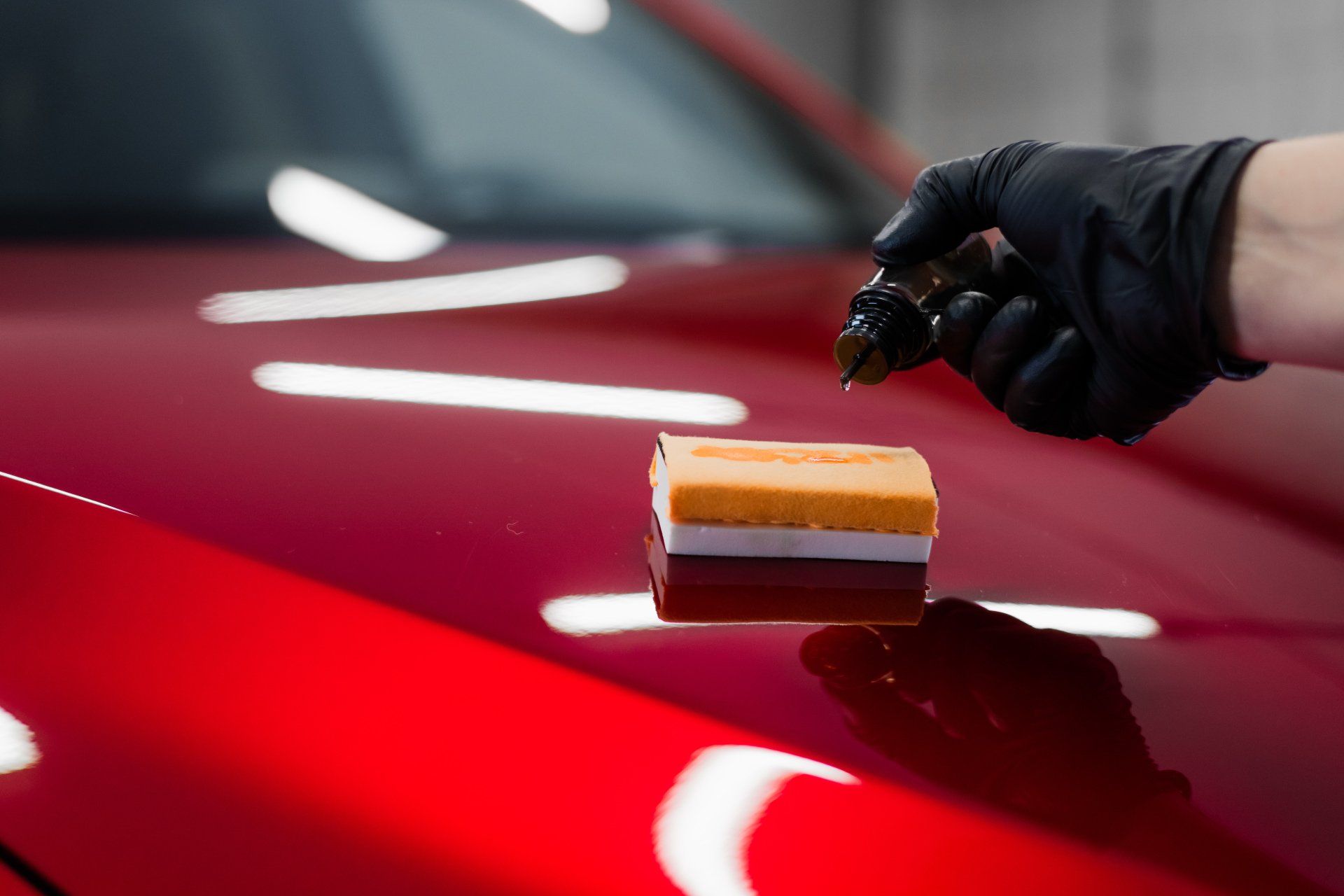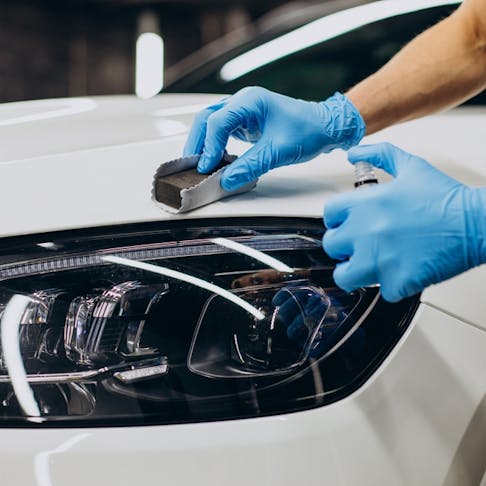How Ceramic Coating Newark can upgrade your vehicle’s look instantly
Exploring the Science Behind Car Ceramic Coating and Its Safety Features
The scientific research of car ceramic coating provides a remarkable research study in innovative auto security. Made up mainly of silicon dioxide and polymers, these coatings create a durable bond with car paint. This interaction enhances durability against environmental risks while supplying hydrophobic benefits. However, the details of how these finishes work and their lasting advantages continue to be less comprehended. Unboxing these details exposes why ceramic layers are ending up being a recommended choice for vehicle care
What Is Ceramic Coating?
Ceramic coating is a fluid polymer that chemically bonds to the surface area of a lorry's paint. This sophisticated safety layer enhances toughness and offers superior resistance to ecological aspects. Unlike standard wax or sealants, which offer temporary protection, ceramic layers develop a durable shield that can withstand harsh conditions such as UV rays, acidic contaminants, and severe weather condition. When applied appropriately, the coating creates a hydrophobic surface, causing water to grain and slide off, which aids in preserving the car's sanitation. In addition, it offers enhanced gloss and deepness to the paint, making the lorry show up more refined and lively. The application procedure generally includes detailed surface preparation, consisting of cleansing and sprucing up, to ensure peak bonding. Therefore, ceramic layers are becoming progressively prominent among car lovers and those seeking to secure their investments, guaranteeing to keep the lorry's visual charm while minimizing the regularity of maintenance.
The Structure of Ceramic Coatings
The complex formula of ceramic finishings mostly consists of silicon dioxide (SiO2), which is originated from natural sources like quartz and sand. This vital component offers the foundation for the coating's durability and safety qualities. Along with SiO2, ceramic layers usually consist of numerous polymers and additives that improve bond, versatility, and resistance to ecological elements. These compounds work synergistically to develop a durable obstacle against contaminants such as dust, chemicals, and UV rays.Furthermore, some formulations integrate titanium dioxide (TiO2) or various other nanomaterials, which can enhance the coating's hydrophobic buildings, causing enhanced water repellency. The specific make-up can vary considerably among suppliers, influencing efficiency and durability. Inevitably, the combination of these components finishes in a protective layer that not only improves the aesthetic allure of cars but also serves to lengthen their lifespan by shielding the surface from potential damage.
Just How Ceramic Coatings Work
Understanding just how ceramic layers work entails exploring their chemical make-up, which adds to their safety high qualities. The application procedure is important for attaining perfect outcomes, while long life and toughness elements establish the coating's effectiveness gradually. With each other, these elements highlight the benefits and efficiency of ceramic coatings for automobile defense.
Chemical Composition Explained
While numerous car proprietors look for lasting protection for their lorries, the chemical composition of ceramic finishings plays a crucial role in their efficiency. These finishings mostly consist of silicon dioxide (SiO2), which is stemmed from natural minerals. This substance develops a solid bond with the lorry's paint, creating a durable, safety layer. Additionally, numerous ceramic coverings consist of titanium dioxide (TiO2), enhancing their hydrophobic residential properties and resistance to UV rays. The presence of polysiloxanes can additionally enhance adaptability and durability. With each other, these elements add to the coating's ability to push back water, dust, and impurities, while additionally giving a high-gloss finish. Comprehending this chemical structure helps car proprietors appreciate the robust security offered by ceramic finishings.
Application Refine Overview
Using ceramic coatings entails a precise procedure that assures perfect bonding and defense for the car's surface. At first, complete cleaning and purification of the car's outside are performed to eliminate dirt, grime, and previous waxes. This action verifies that the surface area is devoid of impurities that might hinder attachment. Following this, the paint is typically brightened to boost clarity and remove any kind of flaws. Once prepared, the ceramic coating is used in little areas utilizing an applicator pad, permitting uniform coverage. The coating is after that delegated heal, forming a solid chemical bond with the surface. Appropriate curing times and problems are critical, as they verify the coating attains its optimum efficiency and safety qualities.
Long Life and Longevity Factors
Ceramic finishes are designed to give long-lasting security via their innovative chemical structure, which develops a durable obstacle versus environmental impurities. The sturdiness of these finishes is influenced by elements such as the thickness of the application, the high quality of the product, and the conditions under which the car is revealed. High-grade ceramic layers can last a number of years, standing up to scratches, UV rays, and chemical discolorations. Proper upkeep, consisting of normal cleaning and regular reapplication, can better improve durability. In addition, ecological variables like climate and exposure to contaminants can influence the lifespan of the coating. Generally, when try this site used and maintained correctly, ceramic finishes offer outstanding toughness, making them a preferred selection for car lovers looking for to preserve their automobile's appearance.
Hydrophobic Features and Water Repellency
Hydrophobic residential or commercial properties are a trademark of quality car ceramic coatings, significantly boosting the automobile's surface area efficiency. These finishes develop a molecular bond with the car's paint, resulting in a surface area that pushes back water successfully. When water enters into contact with a ceramic-coated surface, it grains up and rolls off, decreasing the amount of liquid that continues to be on the paint. This habits not only contributes to a cosmetically pleasing appearance but also decreases the buildup of contaminants such as dirt, gunk, and roadway salts.The enhanced water repellency brings about easier cleansing and upkeep, as less effort is needed to eliminate undesirable compounds. Additionally, the hydrophobic nature of ceramic finishings aids in stopping water areas, which can mar the finish of uncoated surface areas. In general, the consolidation of hydrophobic properties in ceramic finishings plays a necessary function in preserving the lorry's immaculate appearance while simplifying maintenance.
Protection Versus Scratches and UV Damages
Car ceramic coatings supply considerable defense versus scratches and UV damage. The scrape resistance system creates a long lasting layer that absorbs effects, while the UV protecting benefits help preserve the automobile's paint stability gradually. Together, these attributes contribute to a longer-lasting and visually attractive coating.
Damage Resistance Device
Using sophisticated innovation, ceramic finishes supply a durable shield versus scrapes and UV damage, enhancing the durability and look of automobile surface areas. The scrape resistance device of these layers is credited to their distinct molecular framework, which forms a resilient bond with the vehicle's paint. This bond produces a hard, safety layer that can soak up influences and withstand abrasions. In addition, the smooth surface area of the coating decreases friction, making it tough for impurities to adhere and cause scrapes. The chemical structure of ceramic coverings often consists of nanoparticles that enhance the protective layer, more improving its durability. Vehicles treated with ceramic coatings display markedly enhanced scrape resistance contrasted to typical wax or sealants, guaranteeing an excellent coating over time.
UV Shielding Conveniences
The protective top qualities of ceramic finishes prolong past scratch resistance to consist of considerable UV securing advantages. These layers create a durable barrier that shows dangerous ultraviolet rays, securing the vehicle's paint and underlying products. Prolonged exposure to UV radiation can bring about fading, oxidation, and wear and tear of the paint surface. By including ceramic layers, lorry owners can efficiently reduce these risks, maintaining the visual appeal and integrity of their autos. Furthermore, the UV obstructing homes add to enhanced durability, decreasing the frequency of repainting and upkeep. Eventually, the assimilation of ceramic layers supplies a thorough solution for safeguarding lorries from the destructive effects of sunlight More Bonuses direct exposure, making sure a continual, dynamic look over time.
The Durability and Upkeep of Ceramic Coatings

Regularly Asked Questions
Can Ceramic Coating Be Applied to Any Kind Of Type of Automobile?
Ceramic coating can be put on different kinds of automobiles, including cars, trucks, and motorbikes. However, surface preparation and compatibility with details products are necessary for excellent adhesion and performance of the coating.
Just How Much Does Ceramic Coating Typically Cost?
Ceramic coating usually costs in between $500 and $2,000, depending on aspects such as vehicle size, coating quality, and expert application. The investment can offer long-lasting protection and boost the lorry's look in time.

Is Expert Application Required for Ideal Outcomes?
The need of professional application usually depends on preferred results. Specialists commonly guarantee appropriate surface area prep this hyperlink work and application techniques, causing excellent bonding and durability of the coating, which may be testing for inexperienced people to attain.
Can Ceramic Coatings Be Removed or Repaired?
Ceramic finishes can be removed or repaired, though the process might require specific solvents or strategies - Ceramic Coating Newark. Appropriate elimination is vital to stay clear of damages to the underlying surface, stressing the significance of expert support for excellent results
Exactly How Does Porcelain Coating Contrast to Conventional Wax?
The contrast in between ceramic coating and typical wax reveals that ceramic layers provide superior durability, enhanced protection against ecological contaminants, and longer-lasting sparkle, while wax requires extra constant application and offers less total resistance to damage.